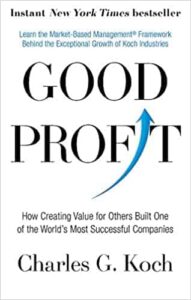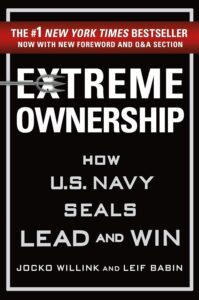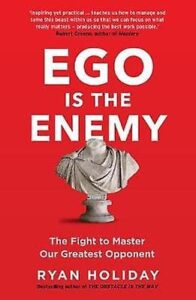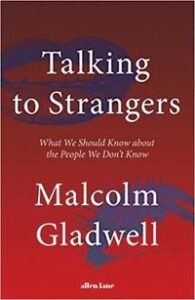Introduction
This book explains a business philosophy called Market-based management (MBM) system which is used by Koch industries. Koch industries had 115 billion dollar in revenue and around 120000 employees in 2021 and he contributes a lot of the success to the MBM system. The book includes a lot of history on how Koch industries was built which this summary will not include. Instead it will contain the information and lessons learned that can be applied into our own life.
The goal of the MBM system is to create a framework and guidelines in how to run a company successfully in the long run. The priorities are to maximize value creation and making sure that the customers and employees are satisfied. Members of a company should have the goal to create value and the MBM system can motivate them to do so. The MBM system consists of 5 parts: vision, virtue and talents, knowledge process, decision rights and incentives.
Vision
The vision should be related to what a company can be contribute to society. The company should have the vision to produce products and services that customer prefer over other alternative options. This should be achieved without spending unnecessary resources such as capital, energy, raw materials and time. Good profit is the result of providing value to customers and society as a whole while acting lawfully and with integrity.
It is important that the company and employee hold similar values in order to produce best results. Every employee should know what to do and feel motivated to do it without too many detailed rules.
An asset should be sold when a buyer will pay more than the assets remaining value.
Virtue and Talents
Hire first based on a persons values then on their talents. Ideally, a person should have good values and is talented but if forced to choose then it’s good values. The reason for this is because talented people with bad values can do more damage to the company. It is also more difficult to find people with good values than good skill.
MBM 10 essential traits and characteristics
- Integrity : Do everything with integrity and don’t do anything you wouldn’t want to be exposed to everyone.
- Compliance: Follow the companies principles and policies. Everyone must be responsible for their own actions.
- Value creation: Create long-term value for the society and customers while avoiding unnecessary resources.
- Entrepreneurship: The employee must be willing to make decisions and come up with new ideas according to the company’s risk philosophy instead of their own. Employees must be held accountable for their behavior and results.
- Customer focus: It’s important to develop long lasting relationship with customers and treat them well.
- Knowledge: Seek and share your knowledge and welcome new challenges.
- Change: Be able to act quickly and correctly when changes happen.
- Humility: Be humble and don’t be arrogant or rude to others.
- Respect: Show respect to the customers and your coworkers.
- Fulfillment: The employee must feel fulfilled and like their job in order to produce maximum value.
These traits should be often reviewed by everyone in the company and each person should be evaluated on them. If this is not done they just become meaningless words. The people who best follow the 10 traits and produce the best results should be promoted. It is the leaders and supervisors who set the standard on what to do and how to behave.
Hiring new employees
New employees should be hired first based on their values and beliefs but talent is also important. Try to anticipate what skills will be needed in the future when looking to hire new people. Instead of hiring when their is a open position, hire when talent is identified even when their is no obvious open position.
To find the right people, encourage all employees to recommend external referrals. Don’t lower your standards no matter how difficult a position is to fill. A bad hiring decision is much more costly then delaying finding the right hire. If a person is talented and there is no prefect role then create and design a job for them. New hires should also be asked what their career goals are and see if they are realistic.
Try to find a supervisor for the new employees in order to train them effectively. The supervisor-employee relationship is very important because this makes it easy to ask question when they arrive and is good for individual growth.
Measuring performance
Each employee should their performance reviewed every now and then. The supervisor should give everyone specific, direct and honest feedback in how they can improve. The three main areas are: main contribution, strengths and areas to improve. If an employee is not performing well then the supervisor should give as specific feedback as possible in how they can improve. The employee must also be open to feedback.
The goal of the review is to identify the top performers and the lowest performing people. The top performers should be rewarded for creating the most value. For the lowest performers ask if they are maybe in the wrong role, if so then switch their role. If this does not work then fire them. When poor performance is not addressed the entire company get affected negatively.
Knowledge Process
Employees should challenge their managers or bosses if they feel they have a better solution to a problem. Managers and bosses should encourage their employees to question and challenge them. Employees should also be able to question managers and bosses if they feel something is not right.
More creativity can be generated by having different members from different teams discuss and work together.
Each employee should continuously be learning and seek more knowledge that can benefit them and the company. It is also important to share this information with others that can benefit from it.
Decision Rights
The person who is most competent should make the decisions because this lead to the most value creation. Competence can be measured with their ability to create value and previous knowledge.
Each employee has a role which consists of two parts: responsibilities and expectations. Both responsibilities and expectations should be defined clearly for the employee.
Decision Traps
Here is a list of common decision traps and mistakes:
- Overconfidence in our ability to make prediction and estimates by not considering more outcomes.
- Framing the proposal in a way that biases our thinking towards a result.
- Anchoring. This is when we here something that influences our decision making. This can for example be when a manager has a strong opinion about the decision.
- Status quo. This means that people don’t like to change and prefer to do things like they always has out of convenience. This can negatively affect the future of a company since they don’t want to change.
- Confirmation bias: This is that people look for information that verifies their point of view and what we want to believe.
- Recency bias: Our decision is influenced by a recent dramatic event.
- History bias: Using history to predict the future when an event is in fact random.
- Conservatism: Employees don’t do what is best for the company because it puts themselves at risk.
How to Propose a New Idea in 7 Steps
- Briefly explain the new proposal or idea.
- Give an explanation of the background and why it is needed.
- Explain the value it will create and how it will do it.
- Prepare an economic overview and how much resources is needed. Plan for different scenarios and think about what can go wrong.
- Describe the risks.
- List other alternative ideas and explain why yours is the best.
- Give a timeline on future steps.
Incentives
Incentives are what motivates an employee to do work and try their best. An employees earnings should be based on the value they create. To make an employee feel like they are being valued is to pay them a portion of the value or earnings they create for the company.
It should be fully possible for a employee to earn more then their manager or supervisor if they create more value. Compensation and bonuses should not be given based on title, certificates, seniority or experience, it should only be given based on value created.
It is important to get to know the employee and their desires. Everyone prefer meaningful work over meaningless work. The aim is to set up an organization so that the employee’s goals matches to company’s goal. The employee must feel like they are working for a good company and a worthy cause and are benefiting others as well as themselves.
Praise should only be given when deserved. False praise goes against trust, respect and honesty.
There are 3 requirements for a human to move: dissatisfaction with their current state, a vision for a better state and a belief that you can achieve that better state.
Failure is to be expected especially when developing new products but it should be avoided if possible. Progress and effort can be rewarded but failure shouldn’t be rewarded.
General Advice and Knowledge
For the MBM system to succeed it requires that everyone in the company on all levels is aware of it, especially the managers and people in leadership. Knowing the MBM system is important but far more important is applying and practicing it in real life.
No one should do everything on their own. They should instead focus on the activity that produces the most value and outsource the rest.
Important values to have and learn according to Charles Koch: integrity, humility, take responsibility, work ethic, entrepreneurship, seek knowledge, the desire to make a contribution and care for others.
Often adversity and failure is a blessing in disguise and is the greatest character builder.
The author hopes that everyone will experience the feeling of accomplishment. The greatest gift is to be able to pursue our passion and in doing so improve the lives of others. To be truly rich is to live a life of meaning.
Creative Destruction
Creative destruction means that old ways of doing things or old businesses are replaced and destroyed by newer methods and newer businesses through innovation. Creative destruction should be encouraged and not stopped since almost everyone will benefit from it. The role of a business should be to satisfy customers. The company who does the best job in satisfying customers should succeed. Disruptive innovations through internal and external development should also be priority.
How New Discoveries Are Made
Deep seated habits and thinking are the results of neurological pathways in the brain which are difficult to change. That’s why culture is hard to change. The natural way is to stick with familiar ways of doing things. But if we want to innovate new things and make new discoveries then brain rewiring is essential.
First we learn and acquire knowledge within a field. This can be facts, terminology and the relationships between things. When we know these details well we can start to focus on the whole. We will then start to see patterns between different things and also be able to sense when something is not right. New discoveries begin when we see a gap between what something currently is and what something could be. We then look more into it and maybe find that there is a new discovery or innovation that can be made. The last step is to explain the hypotheses to others and have it challenged and tested. If it everything works well then people can start working on this new project.





